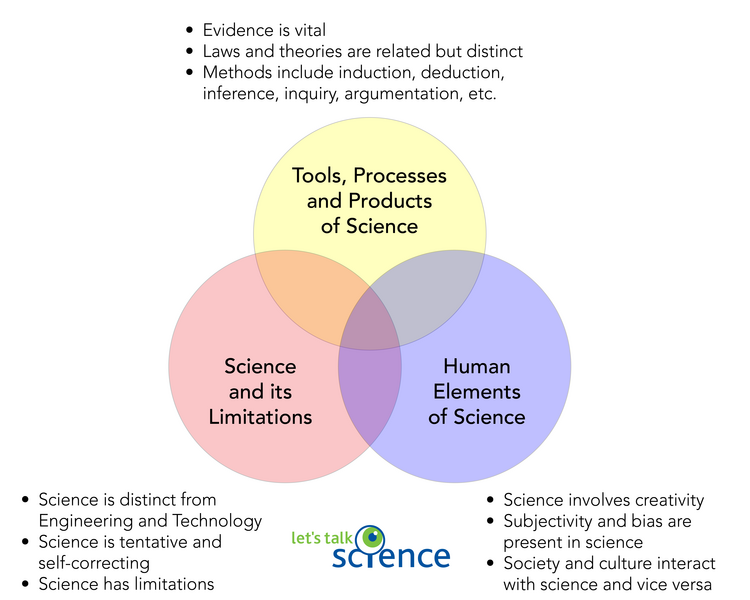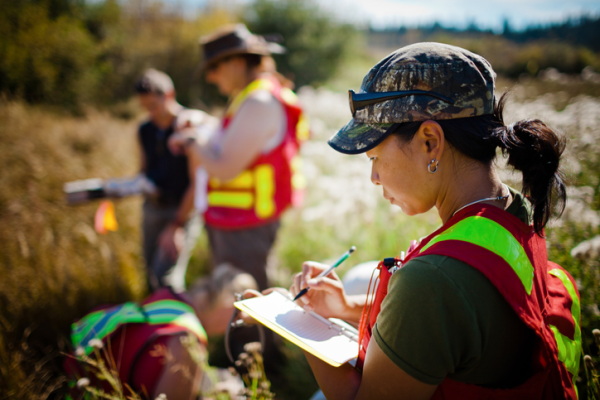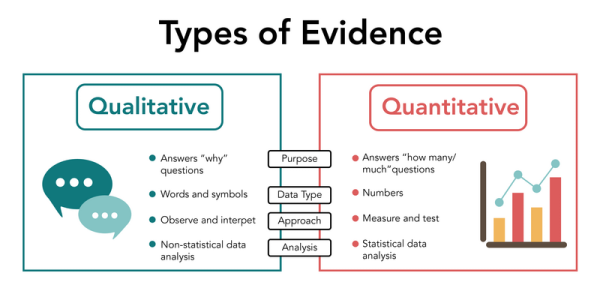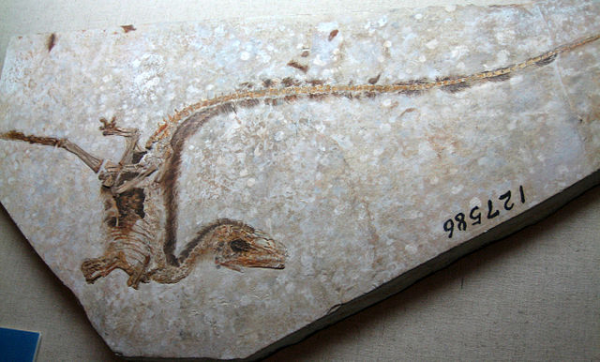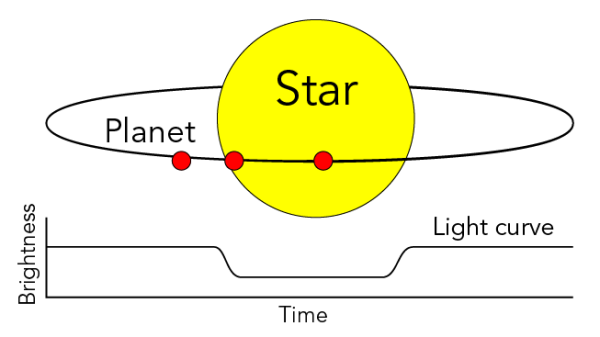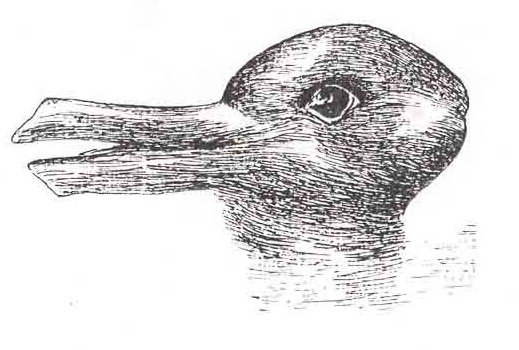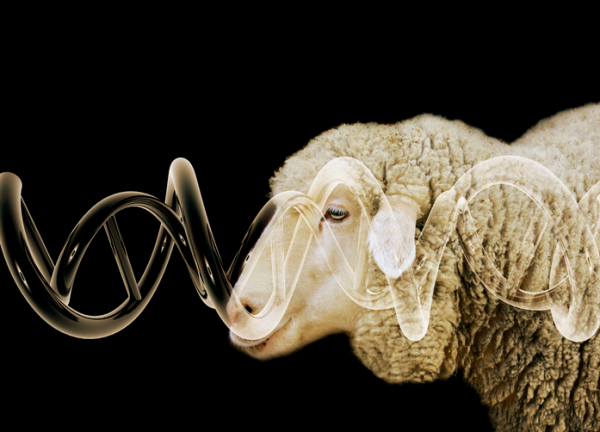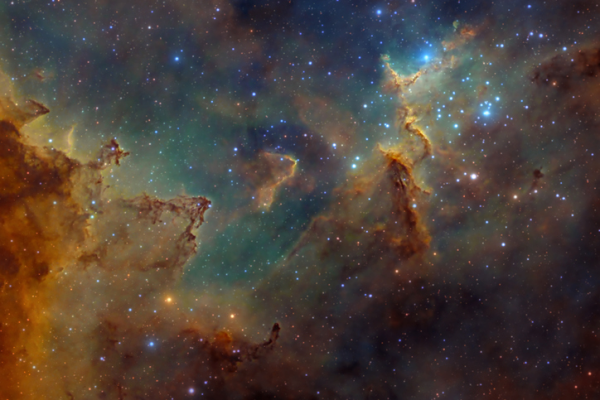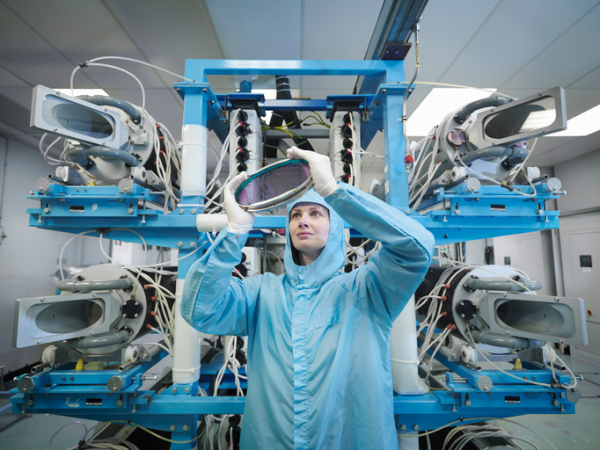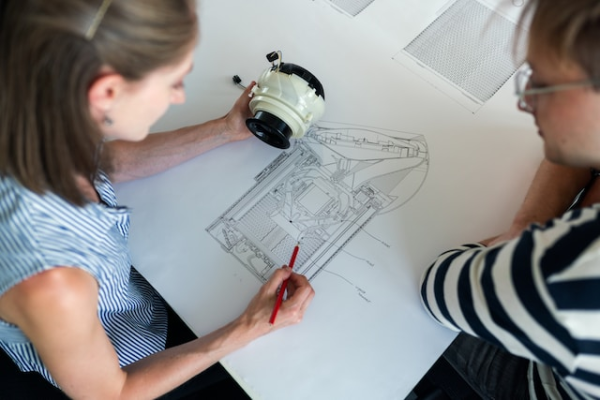In science, evidence refers to the data, observations, and other information that people gather through scientific observation, experimentation, and research. Scientists may collect this information in labs, out in the world, or through computer modelling. Evidence is fundamental to science. Scientists can only make scientific claims and conclusions that are supported by evidence.
Sometimes evidence, or the lack of it, inspires scientists to investigate something further. This can lead to new evidence that may support, or refute, previous conclusions.
Image - Text Version
Shown is a colour photograph of people standing in long grass, writing notes. The person in the foreground is wearing a reflective vest and a baseball cap. Their hair is tied back in a ponytail. They are holding a clipboard and taking notes with a pencil. Two other people are out of focus in the background. One is wearing a reflective vest. The other is holding a clipboard. A third reflective vest is lying on the ground between them. The landscape behind them has long yellow grass, green plants, deciduous and coniferous trees.
For example, consider the night sky. For much of human history, people have looked up to the sky and wondered what was there, how it came to be, and so on. These questions inspired people to want to learn more.
At first, they made observations with their eyes alone. This generated new knowledge and led to new questions. Over time, people wanted to see more. This led to the development of tools such as telescopes. By seeing more, scientists asked more questions.
Over time, scientists realized that there were parts of the night sky that they could not see. This included objects that gave off energy in the electromagnetic spectrum beyond the visible range. This led to the development of even more complex tools that could help them “see” these other types of energy. As scientists learned more with these new tools, they asked new questions and investigated in new ways. This cycle continues today. Such is the power of scientific evidence!
Image - Text Version
Shown is a colour photograph of a person standing on a hill silhouetted by a pinkish glow at the horizon. Most of the photograph shows black sky pin pricked with white stars. A streak of translucent blue and grey gases stretches from the lower centre to the upper right.
The Role of Evidence
In science, evidence refers to the data, observations, and other information that people gather through scientific observation, experimentation, and research. Scientists may collect this information in labs, out in the world, or through computer modelling. Evidence is fundamental to science. Scientists can only make scientific claims and conclusions that are supported by evidence.
Sometimes evidence, or the lack of it, inspires scientists to investigate something further. This can lead to new evidence that may support, or refute, previous conclusions.
Image - Text Version
Shown is a colour photograph of people standing in long grass, writing notes. The person in the foreground is wearing a reflective vest and a baseball cap. Their hair is tied back in a ponytail. They are holding a clipboard and taking notes with a pencil. Two other people are out of focus in the background. One is wearing a reflective vest. The other is holding a clipboard. A third reflective vest is lying on the ground between them. The landscape behind them has long yellow grass, green plants, deciduous and coniferous trees.
For example, consider the night sky. For much of human history, people have looked up to the sky and wondered what was there, how it came to be, and so on. These questions inspired people to want to learn more.
At first, they made observations with their eyes alone. This generated new knowledge and led to new questions. Over time, people wanted to see more. This led to the development of tools such as telescopes. By seeing more, scientists asked more questions.
Over time, scientists realized that there were parts of the night sky that they could not see. This included objects that gave off energy in the electromagnetic spectrum beyond the visible range. This led to the development of even more complex tools that could help them “see” these other types of energy. As scientists learned more with these new tools, they asked new questions and investigated in new ways. This cycle continues today. Such is the power of scientific evidence!
Image - Text Version
Shown is a colour photograph of a person standing on a hill silhouetted by a pinkish glow at the horizon. Most of the photograph shows black sky pin pricked with white stars. A streak of translucent blue and grey gases stretches from the lower centre to the upper right.
The type of evidence scientists consider acceptable depends on the type of scientific investigation.
For some types of investigations, quantitative evidence is obtained. Quantitative evidence is evidence based on measurable observations. It is often generated using statistical data analysis. For some types of investigations, only quantitative evidence is acceptable.
For other types of investigations, quantitative evidence is not possible to obtain. In these cases, qualitative evidence may be acceptable. Qualitative evidence is evidence based on descriptive observations. Scientists use various tools to analyze qualitative data.
Some evidence is stronger than others. The strength of evidence depends on how well an investigation is designed, conducted, and analyzed. It can also depend on factors such as the size of a sample and how many times an investigation is done.
Image - Text Version
Shown is a colour infographic titled “Types of Evidence,” showing the different purposes, data types, approaches and analyses of each. The graphic is divided into two boxes. The left is green and labelled “Qualitative.” The right is orange and labelled “Quantitative.” The left box has an image of two speech bubbles containing three dots each. The right box has an image of a bar graph. The two boxes are connected by four labelled rectangles in the centre. Visually, these link bullet points in each box. The first rectangle is labelled “Purpose.” On the qualitative side, the corresponding bullet point reads, “Answers “why” questions.” On the quantitative side the bullet point reads, “Answers the “how many/how much” questions.” Below, the second rectangle is labelled “DataType.” On the qualitative side, the corresponding bullet point reads, “Words and symbols.” On the quantitative side the bullet point reads, “Numbers.” The third rectangle is labelled “Approach.” On the qualitative side, the corresponding bullet point reads, “Observe and interpret.” On the quantitative side the bullet point reads, “Measure and test.” The fourth rectangle is labelled “Analysis.” On the qualitative side, the corresponding bullet point reads, “Non-statistical data analysis.” On the quantitative side the bullet point reads, “Statistic data analysis.”
Scientists may also use inference to develop evidence. An inference is a conclusion based on available data, prior knowledge, and reasoning. Inference is often used to generate scientific knowledge. It can be very helpful when trying to explain situations or phenomena that we cannot observe.
Scientists often use inference in their examination of fossils. Before paleontologists found fossils of feathered dinosaurs, they inferred the presence of feathers. They based these inferences on other bird-like traits observed in dinosaur fossils. Now that paleontologists have found feathered dinosaur fossils, they wonder about the role of the feathers.
Image - Text Version
Shown is a piece of stone embedded with an image of an animal with a pointed nose and long tail. The stone is smooth, flat, beige and speckled. The image shows one corner of a larger piece. Along the lower edge, the number 127586 is written in black. The animal is in sharp detail. The bones of its skeleton are visible. It has dark eye sockets and a pointed nose. A fuzzy brown stripe leads from its head, along its spine and all the way down its tail. Its tail is more than three times the length of its body and curves past the edge of the image.
Astronomers often use mathematical models to infer the properties of distant objects.
For example, astronomers may infer the existence of a planet around a distant star. They could use observations of light near the star, rather than observations of the planet itself.
Image - Text Version
Shown is a colour diagram of planets orbiting a star, with a graph below showing time, brightness and light curve. In the top centre is a large yellow circle labelled “Star.” This is ringed by a black oval line dotted with three small red circles. One of these is labelled “Planet.” Along the bottom of the diagram is a line graph. The x axis is labelled “Brightness.” The y axis is labelled “Time.” A line labelled “Light curve.” This runs parallel to the y axis, except for a sharp dip, directly below the star.
Types of Evidence
The type of evidence scientists consider acceptable depends on the type of scientific investigation.
For some types of investigations, quantitative evidence is obtained. Quantitative evidence is evidence based on measurable observations. It is often generated using statistical data analysis. For some types of investigations, only quantitative evidence is acceptable.
For other types of investigations, quantitative evidence is not possible to obtain. In these cases, qualitative evidence may be acceptable. Qualitative evidence is evidence based on descriptive observations. Scientists use various tools to analyze qualitative data.
Some evidence is stronger than others. The strength of evidence depends on how well an investigation is designed, conducted, and analyzed. It can also depend on factors such as the size of a sample and how many times an investigation is done.
Image - Text Version
Shown is a colour infographic titled “Types of Evidence,” showing the different purposes, data types, approaches and analyses of each. The graphic is divided into two boxes. The left is green and labelled “Qualitative.” The right is orange and labelled “Quantitative.” The left box has an image of two speech bubbles containing three dots each. The right box has an image of a bar graph. The two boxes are connected by four labelled rectangles in the centre. Visually, these link bullet points in each box. The first rectangle is labelled “Purpose.” On the qualitative side, the corresponding bullet point reads, “Answers “why” questions.” On the quantitative side the bullet point reads, “Answers the “how many/how much” questions.” Below, the second rectangle is labelled “DataType.” On the qualitative side, the corresponding bullet point reads, “Words and symbols.” On the quantitative side the bullet point reads, “Numbers.” The third rectangle is labelled “Approach.” On the qualitative side, the corresponding bullet point reads, “Observe and interpret.” On the quantitative side the bullet point reads, “Measure and test.” The fourth rectangle is labelled “Analysis.” On the qualitative side, the corresponding bullet point reads, “Non-statistical data analysis.” On the quantitative side the bullet point reads, “Statistic data analysis.”
Scientists may also use inference to develop evidence. An inference is a conclusion based on available data, prior knowledge, and reasoning. Inference is often used to generate scientific knowledge. It can be very helpful when trying to explain situations or phenomena that we cannot observe.
Scientists often use inference in their examination of fossils. Before paleontologists found fossils of feathered dinosaurs, they inferred the presence of feathers. They based these inferences on other bird-like traits observed in dinosaur fossils. Now that paleontologists have found feathered dinosaur fossils, they wonder about the role of the feathers.
Image - Text Version
Shown is a piece of stone embedded with an image of an animal with a pointed nose and long tail. The stone is smooth, flat, beige and speckled. The image shows one corner of a larger piece. Along the lower edge, the number 127586 is written in black. The animal is in sharp detail. The bones of its skeleton are visible. It has dark eye sockets and a pointed nose. A fuzzy brown stripe leads from its head, along its spine and all the way down its tail. Its tail is more than three times the length of its body and curves past the edge of the image.
Astronomers often use mathematical models to infer the properties of distant objects.
For example, astronomers may infer the existence of a planet around a distant star. They could use observations of light near the star, rather than observations of the planet itself.
Image - Text Version
Shown is a colour diagram of planets orbiting a star, with a graph below showing time, brightness and light curve. In the top centre is a large yellow circle labelled “Star.” This is ringed by a black oval line dotted with three small red circles. One of these is labelled “Planet.” Along the bottom of the diagram is a line graph. The x axis is labelled “Brightness.” The y axis is labelled “Time.” A line labelled “Light curve.” This runs parallel to the y axis, except for a sharp dip, directly below the star.
In science, evidence refers to the data, observations, and other information that people gather through scientific observation, experimentation, and research. Scientists may collect this information in labs, out in the world, or through computer modelling. Evidence is fundamental to science. Scientists can only make scientific claims and conclusions that are supported by evidence.
Sometimes evidence, or the lack of it, inspires scientists to investigate something further. This can lead to new evidence that may support, or refute, previous conclusions.
Image - Text Version
Shown is a colour photograph of people standing in long grass, writing notes. The person in the foreground is wearing a reflective vest and a baseball cap. Their hair is tied back in a ponytail. They are holding a clipboard and taking notes with a pencil. Two other people are out of focus in the background. One is wearing a reflective vest. The other is holding a clipboard. A third reflective vest is lying on the ground between them. The landscape behind them has long yellow grass, green plants, deciduous and coniferous trees.
For example, consider the night sky. For much of human history, people have looked up to the sky and wondered what was there, how it came to be, and so on. These questions inspired people to want to learn more.
At first, they made observations with their eyes alone. This generated new knowledge and led to new questions. Over time, people wanted to see more. This led to the development of tools such as telescopes. By seeing more, scientists asked more questions.
Over time, scientists realized that there were parts of the night sky that they could not see. This included objects that gave off energy in the electromagnetic spectrum beyond the visible range. This led to the development of even more complex tools that could help them “see” these other types of energy. As scientists learned more with these new tools, they asked new questions and investigated in new ways. This cycle continues today. Such is the power of scientific evidence!
Image - Text Version
Shown is a colour photograph of a person standing on a hill silhouetted by a pinkish glow at the horizon. Most of the photograph shows black sky pin pricked with white stars. A streak of translucent blue and grey gases stretches from the lower centre to the upper right.
The Role of Evidence
In science, evidence refers to the data, observations, and other information that people gather through scientific observation, experimentation, and research. Scientists may collect this information in labs, out in the world, or through computer modelling. Evidence is fundamental to science. Scientists can only make scientific claims and conclusions that are supported by evidence.
Sometimes evidence, or the lack of it, inspires scientists to investigate something further. This can lead to new evidence that may support, or refute, previous conclusions.
Image - Text Version
Shown is a colour photograph of people standing in long grass, writing notes. The person in the foreground is wearing a reflective vest and a baseball cap. Their hair is tied back in a ponytail. They are holding a clipboard and taking notes with a pencil. Two other people are out of focus in the background. One is wearing a reflective vest. The other is holding a clipboard. A third reflective vest is lying on the ground between them. The landscape behind them has long yellow grass, green plants, deciduous and coniferous trees.
For example, consider the night sky. For much of human history, people have looked up to the sky and wondered what was there, how it came to be, and so on. These questions inspired people to want to learn more.
At first, they made observations with their eyes alone. This generated new knowledge and led to new questions. Over time, people wanted to see more. This led to the development of tools such as telescopes. By seeing more, scientists asked more questions.
Over time, scientists realized that there were parts of the night sky that they could not see. This included objects that gave off energy in the electromagnetic spectrum beyond the visible range. This led to the development of even more complex tools that could help them “see” these other types of energy. As scientists learned more with these new tools, they asked new questions and investigated in new ways. This cycle continues today. Such is the power of scientific evidence!
Image - Text Version
Shown is a colour photograph of a person standing on a hill silhouetted by a pinkish glow at the horizon. Most of the photograph shows black sky pin pricked with white stars. A streak of translucent blue and grey gases stretches from the lower centre to the upper right.
The type of evidence scientists consider acceptable depends on the type of scientific investigation.
For some types of investigations, quantitative evidence is obtained. Quantitative evidence is evidence based on measurable observations. It is often generated using statistical data analysis. For some types of investigations, only quantitative evidence is acceptable.
For other types of investigations, quantitative evidence is not possible to obtain. In these cases, qualitative evidence may be acceptable. Qualitative evidence is evidence based on descriptive observations. Scientists use various tools to analyze qualitative data.
Some evidence is stronger than others. The strength of evidence depends on how well an investigation is designed, conducted, and analyzed. It can also depend on factors such as the size of a sample and how many times an investigation is done.
Image - Text Version
Shown is a colour infographic titled “Types of Evidence,” showing the different purposes, data types, approaches and analyses of each. The graphic is divided into two boxes. The left is green and labelled “Qualitative.” The right is orange and labelled “Quantitative.” The left box has an image of two speech bubbles containing three dots each. The right box has an image of a bar graph. The two boxes are connected by four labelled rectangles in the centre. Visually, these link bullet points in each box. The first rectangle is labelled “Purpose.” On the qualitative side, the corresponding bullet point reads, “Answers “why” questions.” On the quantitative side the bullet point reads, “Answers the “how many/how much” questions.” Below, the second rectangle is labelled “DataType.” On the qualitative side, the corresponding bullet point reads, “Words and symbols.” On the quantitative side the bullet point reads, “Numbers.” The third rectangle is labelled “Approach.” On the qualitative side, the corresponding bullet point reads, “Observe and interpret.” On the quantitative side the bullet point reads, “Measure and test.” The fourth rectangle is labelled “Analysis.” On the qualitative side, the corresponding bullet point reads, “Non-statistical data analysis.” On the quantitative side the bullet point reads, “Statistic data analysis.”
Scientists may also use inference to develop evidence. An inference is a conclusion based on available data, prior knowledge, and reasoning. Inference is often used to generate scientific knowledge. It can be very helpful when trying to explain situations or phenomena that we cannot observe.
Scientists often use inference in their examination of fossils. Before paleontologists found fossils of feathered dinosaurs, they inferred the presence of feathers. They based these inferences on other bird-like traits observed in dinosaur fossils. Now that paleontologists have found feathered dinosaur fossils, they wonder about the role of the feathers.
Image - Text Version
Shown is a piece of stone embedded with an image of an animal with a pointed nose and long tail. The stone is smooth, flat, beige and speckled. The image shows one corner of a larger piece. Along the lower edge, the number 127586 is written in black. The animal is in sharp detail. The bones of its skeleton are visible. It has dark eye sockets and a pointed nose. A fuzzy brown stripe leads from its head, along its spine and all the way down its tail. Its tail is more than three times the length of its body and curves past the edge of the image.
Astronomers often use mathematical models to infer the properties of distant objects.
For example, astronomers may infer the existence of a planet around a distant star. They could use observations of light near the star, rather than observations of the planet itself.
Image - Text Version
Shown is a colour diagram of planets orbiting a star, with a graph below showing time, brightness and light curve. In the top centre is a large yellow circle labelled “Star.” This is ringed by a black oval line dotted with three small red circles. One of these is labelled “Planet.” Along the bottom of the diagram is a line graph. The x axis is labelled “Brightness.” The y axis is labelled “Time.” A line labelled “Light curve.” This runs parallel to the y axis, except for a sharp dip, directly below the star.
Types of Evidence
The type of evidence scientists consider acceptable depends on the type of scientific investigation.
For some types of investigations, quantitative evidence is obtained. Quantitative evidence is evidence based on measurable observations. It is often generated using statistical data analysis. For some types of investigations, only quantitative evidence is acceptable.
For other types of investigations, quantitative evidence is not possible to obtain. In these cases, qualitative evidence may be acceptable. Qualitative evidence is evidence based on descriptive observations. Scientists use various tools to analyze qualitative data.
Some evidence is stronger than others. The strength of evidence depends on how well an investigation is designed, conducted, and analyzed. It can also depend on factors such as the size of a sample and how many times an investigation is done.
Image - Text Version
Shown is a colour infographic titled “Types of Evidence,” showing the different purposes, data types, approaches and analyses of each. The graphic is divided into two boxes. The left is green and labelled “Qualitative.” The right is orange and labelled “Quantitative.” The left box has an image of two speech bubbles containing three dots each. The right box has an image of a bar graph. The two boxes are connected by four labelled rectangles in the centre. Visually, these link bullet points in each box. The first rectangle is labelled “Purpose.” On the qualitative side, the corresponding bullet point reads, “Answers “why” questions.” On the quantitative side the bullet point reads, “Answers the “how many/how much” questions.” Below, the second rectangle is labelled “DataType.” On the qualitative side, the corresponding bullet point reads, “Words and symbols.” On the quantitative side the bullet point reads, “Numbers.” The third rectangle is labelled “Approach.” On the qualitative side, the corresponding bullet point reads, “Observe and interpret.” On the quantitative side the bullet point reads, “Measure and test.” The fourth rectangle is labelled “Analysis.” On the qualitative side, the corresponding bullet point reads, “Non-statistical data analysis.” On the quantitative side the bullet point reads, “Statistic data analysis.”
Scientists may also use inference to develop evidence. An inference is a conclusion based on available data, prior knowledge, and reasoning. Inference is often used to generate scientific knowledge. It can be very helpful when trying to explain situations or phenomena that we cannot observe.
Scientists often use inference in their examination of fossils. Before paleontologists found fossils of feathered dinosaurs, they inferred the presence of feathers. They based these inferences on other bird-like traits observed in dinosaur fossils. Now that paleontologists have found feathered dinosaur fossils, they wonder about the role of the feathers.
Image - Text Version
Shown is a piece of stone embedded with an image of an animal with a pointed nose and long tail. The stone is smooth, flat, beige and speckled. The image shows one corner of a larger piece. Along the lower edge, the number 127586 is written in black. The animal is in sharp detail. The bones of its skeleton are visible. It has dark eye sockets and a pointed nose. A fuzzy brown stripe leads from its head, along its spine and all the way down its tail. Its tail is more than three times the length of its body and curves past the edge of the image.
Astronomers often use mathematical models to infer the properties of distant objects.
For example, astronomers may infer the existence of a planet around a distant star. They could use observations of light near the star, rather than observations of the planet itself.
Image - Text Version
Shown is a colour diagram of planets orbiting a star, with a graph below showing time, brightness and light curve. In the top centre is a large yellow circle labelled “Star.” This is ringed by a black oval line dotted with three small red circles. One of these is labelled “Planet.” Along the bottom of the diagram is a line graph. The x axis is labelled “Brightness.” The y axis is labelled “Time.” A line labelled “Light curve.” This runs parallel to the y axis, except for a sharp dip, directly below the star.
In both these cases, inference allowed scientists to add to the scientific body of knowledge.
It is important to recognize that evidence based on inference is not an opinion or a guess. Scientists base their inferences on observations and existing knowledge. As new evidence becomes available, inferences can change.
Try this!
How important is evidence in your personal decision-making? Which is more important in your personal decision-making - quantitative or qualitative evidence?
People use the words “theory” and “law” in everyday conversation. Yet, their meaning is often not the same as their meaning in science. Theories and laws are related, but they do not mean the same thing in science.
Laws are generalized statements about observed patterns in nature. Theories are the explanations of those generalizations.
Laws are based on observations. They describe what will happen in certain circumstances. For example, Newton’s Law of Universal Gravitation describes what happens when we drop something. It doesn’t matter if we are at the top of a mountain or deep underground. The object will always fall towards the centre of the Earth. There is no situation that we know of in which a dropped object will fall upwards.
Image - Text Version
Shown is a colour photograph of a child surrounded by apple trees. The child is smiling and looking down with their eyes closed. They are dropping a green apple from one hand onto the top of their head. The child is wearing a green, hooded raincoat. Grey sky can be seen through the leaves in the distance.
Theories use observations and inferences to explain events. They explain why something happens. For example, why objects move the way they do is because of gravitational forces.
Both theories and laws are based on evidence, and hence, are subject to change if evidence changes. Both may be revised in the light of contradictory evidence. Laws are less likely to change than theories because they only describe a phenomenon; they do not explain it. A key understanding for students is that theories do not become laws and laws do not become theories.
Theories vs Laws
People use the words “theory” and “law” in everyday conversation. Yet, their meaning is often not the same as their meaning in science. Theories and laws are related, but they do not mean the same thing in science.
Laws are generalized statements about observed patterns in nature. Theories are the explanations of those generalizations.
Laws are based on observations. They describe what will happen in certain circumstances. For example, Newton’s Law of Universal Gravitation describes what happens when we drop something. It doesn’t matter if we are at the top of a mountain or deep underground. The object will always fall towards the centre of the Earth. There is no situation that we know of in which a dropped object will fall upwards.
Image - Text Version
Shown is a colour photograph of a child surrounded by apple trees. The child is smiling and looking down with their eyes closed. They are dropping a green apple from one hand onto the top of their head. The child is wearing a green, hooded raincoat. Grey sky can be seen through the leaves in the distance.
Theories use observations and inferences to explain events. They explain why something happens. For example, why objects move the way they do is because of gravitational forces.
Both theories and laws are based on evidence, and hence, are subject to change if evidence changes. Both may be revised in the light of contradictory evidence. Laws are less likely to change than theories because they only describe a phenomenon; they do not explain it. A key understanding for students is that theories do not become laws and laws do not become theories.
The Methods of Science
Scientific methods refer to how professional scientists gather evidence. Students learn about these methods in school, frequently by using the so-called "scientific method". This can lead to the misconception that there is a single, step-by-step method for doing science. While professional scientists use many common methods, there is no single method that everyone follows.
Image - Text Version
Shown is a colour photograph of a person holding a tablet over a small plant. Only the person’s knee, arms and hands are visible. They are kneeling next to rows of small green plants in black bags, filled with soil. They are holding the black tablet in one hand, and a stem with several green leaves in the other. Rows of much larger green plants are visible in the distance.
These shared methods include what are often called “science process skills”. This includes skills such as analyzing, communicating, recording and predicting.
Yet, scientific methods go beyond simple “how to” skills. They also include things like using logic, making models, and reviewing existing information. Methods also need to embed things such as ethical standards and review. Just as scientists must select appropriate tools, they must also select appropriate methods for what they are studying. For example, a climate scientist would use quantitative research methods and statistics. A chemist doing drug trials would use experimental methods to either prove or disprove a hypothesis. A scientist studying how anxiety is experienced in different cultures would use descriptive investigation methods.
The Methods of Science
The Methods of Science
Scientific methods refer to how professional scientists gather evidence. Students learn about these methods in school, frequently by using the so-called "scientific method". This can lead to the misconception that there is a single, step-by-step method for doing science. While professional scientists use many common methods, there is no single method that everyone follows.
Image - Text Version
Shown is a colour photograph of a person holding a tablet over a small plant. Only the person’s knee, arms and hands are visible. They are kneeling next to rows of small green plants in black bags, filled with soil. They are holding the black tablet in one hand, and a stem with several green leaves in the other. Rows of much larger green plants are visible in the distance.
These shared methods include what are often called “science process skills”. This includes skills such as analyzing, communicating, recording and predicting.
Yet, scientific methods go beyond simple “how to” skills. They also include things like using logic, making models, and reviewing existing information. Methods also need to embed things such as ethical standards and review. Just as scientists must select appropriate tools, they must also select appropriate methods for what they are studying. For example, a climate scientist would use quantitative research methods and statistics. A chemist doing drug trials would use experimental methods to either prove or disprove a hypothesis. A scientist studying how anxiety is experienced in different cultures would use descriptive investigation methods.
People use the words “theory” and “law” in everyday conversation. Yet, their meaning is often not the same as their meaning in science. Theories and laws are related, but they do not mean the same thing in science.
Laws are generalized statements about observed patterns in nature. Theories are the explanations of those generalizations.
Laws are based on observations. They describe what will happen in certain circumstances. For example, Newton’s Law of Universal Gravitation describes what happens when we drop something. It doesn’t matter if we are at the top of a mountain or deep underground. The object will always fall towards the centre of the Earth. There is no situation that we know of in which a dropped object will fall upwards.
Image - Text Version
Shown is a colour photograph of a child surrounded by apple trees. The child is smiling and looking down with their eyes closed. They are dropping a green apple from one hand onto the top of their head. The child is wearing a green, hooded raincoat. Grey sky can be seen through the leaves in the distance.
Theories use observations and inferences to explain events. They explain why something happens. For example, why objects move the way they do is because of gravitational forces.
Both theories and laws are based on evidence, and hence, are subject to change if evidence changes. Both may be revised in the light of contradictory evidence. Laws are less likely to change than theories because they only describe a phenomenon; they do not explain it. A key understanding for students is that theories do not become laws and laws do not become theories.
Theories vs Laws
People use the words “theory” and “law” in everyday conversation. Yet, their meaning is often not the same as their meaning in science. Theories and laws are related, but they do not mean the same thing in science.
Laws are generalized statements about observed patterns in nature. Theories are the explanations of those generalizations.
Laws are based on observations. They describe what will happen in certain circumstances. For example, Newton’s Law of Universal Gravitation describes what happens when we drop something. It doesn’t matter if we are at the top of a mountain or deep underground. The object will always fall towards the centre of the Earth. There is no situation that we know of in which a dropped object will fall upwards.
Image - Text Version
Shown is a colour photograph of a child surrounded by apple trees. The child is smiling and looking down with their eyes closed. They are dropping a green apple from one hand onto the top of their head. The child is wearing a green, hooded raincoat. Grey sky can be seen through the leaves in the distance.
Theories use observations and inferences to explain events. They explain why something happens. For example, why objects move the way they do is because of gravitational forces.
Both theories and laws are based on evidence, and hence, are subject to change if evidence changes. Both may be revised in the light of contradictory evidence. Laws are less likely to change than theories because they only describe a phenomenon; they do not explain it. A key understanding for students is that theories do not become laws and laws do not become theories.
The Methods of Science
Scientific methods refer to how professional scientists gather evidence. Students learn about these methods in school, frequently by using the so-called "scientific method". This can lead to the misconception that there is a single, step-by-step method for doing science. While professional scientists use many common methods, there is no single method that everyone follows.
Image - Text Version
Shown is a colour photograph of a person holding a tablet over a small plant. Only the person’s knee, arms and hands are visible. They are kneeling next to rows of small green plants in black bags, filled with soil. They are holding the black tablet in one hand, and a stem with several green leaves in the other. Rows of much larger green plants are visible in the distance.
These shared methods include what are often called “science process skills”. This includes skills such as analyzing, communicating, recording and predicting.
Yet, scientific methods go beyond simple “how to” skills. They also include things like using logic, making models, and reviewing existing information. Methods also need to embed things such as ethical standards and review. Just as scientists must select appropriate tools, they must also select appropriate methods for what they are studying. For example, a climate scientist would use quantitative research methods and statistics. A chemist doing drug trials would use experimental methods to either prove or disprove a hypothesis. A scientist studying how anxiety is experienced in different cultures would use descriptive investigation methods.
The Methods of Science
The Methods of Science
Scientific methods refer to how professional scientists gather evidence. Students learn about these methods in school, frequently by using the so-called "scientific method". This can lead to the misconception that there is a single, step-by-step method for doing science. While professional scientists use many common methods, there is no single method that everyone follows.
Image - Text Version
Shown is a colour photograph of a person holding a tablet over a small plant. Only the person’s knee, arms and hands are visible. They are kneeling next to rows of small green plants in black bags, filled with soil. They are holding the black tablet in one hand, and a stem with several green leaves in the other. Rows of much larger green plants are visible in the distance.
These shared methods include what are often called “science process skills”. This includes skills such as analyzing, communicating, recording and predicting.
Yet, scientific methods go beyond simple “how to” skills. They also include things like using logic, making models, and reviewing existing information. Methods also need to embed things such as ethical standards and review. Just as scientists must select appropriate tools, they must also select appropriate methods for what they are studying. For example, a climate scientist would use quantitative research methods and statistics. A chemist doing drug trials would use experimental methods to either prove or disprove a hypothesis. A scientist studying how anxiety is experienced in different cultures would use descriptive investigation methods.
Did you know?
The three main types of scientific investigations are Descriptive Investigations, Comparative Investigations, and Experimental Investigations.
The Human Elements of Science
Since science is a human activity, it stands to reason that the things that make us human will show up in how scientists “do science”.
Creativity and imagination are often associated with art, music, and literature. Students may think that creativity is not important in science. This is far from the truth.
Scientists use their creativity and imagination at all stages of science investigation. They use their imagination when they consider what to investigate and which questions to ask. They use their creativity when they consider how they will find answers to their questions.
Imagine trying to find a way of measuring the size of a school of fish. Or how to grow plants on Mars. You would not be able to do either without being creative or imaginative!
Image - Text Version
Shown is a colour photograph of a child touching the wheel of a model motorcycle. The child has an expression of wonder and curiosity. Their face is in focus on the left. They are reaching out with one hand to the motorcycle on the right. These are out of focus. The space around the child is dark.
Just as there is no single scientific method, there is also no one right way to analyze data. "Creative insight" often helps find patterns or connections in data. These explanations aren't merely intuition. They are informed by a scientist's broad knowledge and experiences.
Creativity and Imagination
Creativity and imagination are often associated with art, music, and literature. Students may think that creativity is not important in science. This is far from the truth.
Scientists use their creativity and imagination at all stages of science investigation. They use their imagination when they consider what to investigate and which questions to ask. They use their creativity when they consider how they will find answers to their questions.
Imagine trying to find a way of measuring the size of a school of fish. Or how to grow plants on Mars. You would not be able to do either without being creative or imaginative!
Image - Text Version
Shown is a colour photograph of a child touching the wheel of a model motorcycle. The child has an expression of wonder and curiosity. Their face is in focus on the left. They are reaching out with one hand to the motorcycle on the right. These are out of focus. The space around the child is dark.
Just as there is no single scientific method, there is also no one right way to analyze data. "Creative insight" often helps find patterns or connections in data. These explanations aren't merely intuition. They are informed by a scientist's broad knowledge and experiences.
The majority of Canadians have confidence in scientists. They trust that scientists act objectively. The ability to be objective is a central feature of a scientist’s behaviour. When a person is being objective, it means that they are acting and making decisions based on facts and not on personal views. In other words, they act in an unbiased way. While all scientists strive to be as objective and unbiased as they can, it is a difficult task.
Science is objective; Scientists are human.
Like all people, scientists see the world through their experiences and prior knowledge. These experiences and knowledge create unconscious biases and expectations about the world. For example, two people can see the same image and come away with completely different meanings.
What do you see when you look at the image on the right? What meaning can you make from it? Your answers will depend on your knowledge and experiences.
Image - Text Version
Shown is a black and white line drawing of an animal’s head. The animal’s head is oval-shaped with a soft texture. One large, dark eye is visible near the centre. Two long, pointed structures extend horizontally from the left side of the head.
Try this!
Think of a time when you engaged in a scientific experiment or STEM project. In what ways did subjectivity come into play? What personal biases might you have brought to the decision-making process?
Another way that scientists reduce the effects of bias is that they seldom work alone. They almost always work in teams and get feedback and suggestions from team members. By reviewing each other’s work, scientists can help to spot bias and subjectivity. This is a type of peer review. Ideas and tentative results are also often shared within the broader scientific community. This community can also provide important feedback before findings are shared publicly.
The most common form of peer review happens when scientific results are ready to be published. Results are often published as papers in scientific journals. Before a paper is accepted by a journal, it must first go through a peer review process. During this process, experts in the field evaluate the originality, validity and rigour of the research.
These various types of peer review help limit the effect that bias and subjectivity can have on scientists’ work.
Other ways of avoiding and limiting the effects of bias include:
- Developing clearly defined research plans that includes an analysis of the potential biases,
- Analyzing pre-research assumptions and guarding against leading questions,
- Standardizing the role of the investigator, especially when engaging in qualitative research,
- Including others in the analysis and interpretation of data, and
- Keeping detailed records at each step during the research process.
Finally, as we will discuss in the next section, having a diverse population of scientists also plays a role in reducing the effects of bias and subjectivity in scientific research.
Did you know?
9 out of 10 researchers feel that peer review improves the quality of their published paper.
Subjectivity and Bias
The majority of Canadians have confidence in scientists. They trust that scientists act objectively. The ability to be objective is a central feature of a scientist’s behaviour. When a person is being objective, it means that they are acting and making decisions based on facts and not on personal views. In other words, they act in an unbiased way. While all scientists strive to be as objective and unbiased as they can, it is a difficult task.
Science is objective; Scientists are human.
Like all people, scientists see the world through their experiences and prior knowledge. These experiences and knowledge create unconscious biases and expectations about the world. For example, two people can see the same image and come away with completely different meanings.
What do you see when you look at the image on the right? What meaning can you make from it? Your answers will depend on your knowledge and experiences.
Image - Text Version
Shown is a black and white line drawing of an animal’s head. The animal’s head is oval-shaped with a soft texture. One large, dark eye is visible near the centre. Two long, pointed structures extend horizontally from the left side of the head.
Try this!
Think of a time when you engaged in a scientific experiment or STEM project. In what ways did subjectivity come into play? What personal biases might you have brought to the decision-making process?
Another way that scientists reduce the effects of bias is that they seldom work alone. They almost always work in teams and get feedback and suggestions from team members. By reviewing each other’s work, scientists can help to spot bias and subjectivity. This is a type of peer review. Ideas and tentative results are also often shared within the broader scientific community. This community can also provide important feedback before findings are shared publicly.
The most common form of peer review happens when scientific results are ready to be published. Results are often published as papers in scientific journals. Before a paper is accepted by a journal, it must first go through a peer review process. During this process, experts in the field evaluate the originality, validity and rigour of the research.
These various types of peer review help limit the effect that bias and subjectivity can have on scientists’ work.
Other ways of avoiding and limiting the effects of bias include:
- Developing clearly defined research plans that includes an analysis of the potential biases,
- Analyzing pre-research assumptions and guarding against leading questions,
- Standardizing the role of the investigator, especially when engaging in qualitative research,
- Including others in the analysis and interpretation of data, and
- Keeping detailed records at each step during the research process.
Finally, as we will discuss in the next section, having a diverse population of scientists also plays a role in reducing the effects of bias and subjectivity in scientific research.
Did you know?
9 out of 10 researchers feel that peer review improves the quality of their published paper.
Society and culture can have a huge impact on what gets studied and how studies are done.
Our personal ethics, values, beliefs, and morals all shape our worldview. As mentioned earlier, this can lead to unconscious bias and subjectivity. Bias can influence which questions are studied and how data is interpreted. For example, scientific research is usually funded by outside groups. If the given research doesn't align with the interests of the funding organizations, scientists may struggle to secure the necessary funding.
The scientific community also reflects the ethical standards and moral values of society. Research that contradicts societal norms, or is unethical, will not be allowed to take place. In some societies this has included research in cloning and stem cells.
Image - Text Version
Shown is a colour photograph of a sheep, overlaid with an image of a DNA strand. The sheep has heavy-lidded eyes and thick, beige wool. The translucent, coiled double helix strand runs horizontally across the whole image, including the animal’s face and body. The background is plain black.
Social norms also affect who can pursue a career in science. Systemic barriers, such as racism, sexism, and homophobia are present in the scientific community just as they are in the larger society. While many colleges and universities have taken steps to remove these barriers, more needs to be done. To address these persistent barriers, individuals at all levels must work to develop and apply equity-based and anti-racist practices.
Did you know?
In 2019, only 12% of full-time Canadian university faculty in physical, life sciences and technologies, were women.
Society and Culture
Society and culture can have a huge impact on what gets studied and how studies are done.
Our personal ethics, values, beliefs, and morals all shape our worldview. As mentioned earlier, this can lead to unconscious bias and subjectivity. Bias can influence which questions are studied and how data is interpreted. For example, scientific research is usually funded by outside groups. If the given research doesn't align with the interests of the funding organizations, scientists may struggle to secure the necessary funding.
The scientific community also reflects the ethical standards and moral values of society. Research that contradicts societal norms, or is unethical, will not be allowed to take place. In some societies this has included research in cloning and stem cells.
Image - Text Version
Shown is a colour photograph of a sheep, overlaid with an image of a DNA strand. The sheep has heavy-lidded eyes and thick, beige wool. The translucent, coiled double helix strand runs horizontally across the whole image, including the animal’s face and body. The background is plain black.
Social norms also affect who can pursue a career in science. Systemic barriers, such as racism, sexism, and homophobia are present in the scientific community just as they are in the larger society. While many colleges and universities have taken steps to remove these barriers, more needs to be done. To address these persistent barriers, individuals at all levels must work to develop and apply equity-based and anti-racist practices.
Did you know?
In 2019, only 12% of full-time Canadian university faculty in physical, life sciences and technologies, were women.
Our society often fosters misunderstandings and false information about science. For instance, media outlets prioritize attracting a wide audience to make profits. This can lead to exaggerated or misleading headlines about scientific research. When subsequent studies debunk earlier reports, media coverage of them is often scant or absent.
The internet and social media make this problem worse by rapidly spreading inaccuracies and misinformation. One reason for this is that algorithms used by search engines and social platforms prioritize content based on user preferences. This often boosts positive-sounding scientific papers in search results. The popularity of a given scientist's work can influence their career progression and funding opportunities. It can even create situations where individual scientists hype their work or engage in fraudulent activity to rank higher in search results.
Science, Society and Misinformation
Our society often fosters misunderstandings and false information about science. For instance, media outlets prioritize attracting a wide audience to make profits. This can lead to exaggerated or misleading headlines about scientific research. When subsequent studies debunk earlier reports, media coverage of them is often scant or absent.
The internet and social media make this problem worse by rapidly spreading inaccuracies and misinformation. One reason for this is that algorithms used by search engines and social platforms prioritize content based on user preferences. This often boosts positive-sounding scientific papers in search results. The popularity of a given scientist's work can influence their career progression and funding opportunities. It can even create situations where individual scientists hype their work or engage in fraudulent activity to rank higher in search results.
Creativity and imagination are often associated with art, music, and literature. Students may think that creativity is not important in science. This is far from the truth.
Scientists use their creativity and imagination at all stages of science investigation. They use their imagination when they consider what to investigate and which questions to ask. They use their creativity when they consider how they will find answers to their questions.
Imagine trying to find a way of measuring the size of a school of fish. Or how to grow plants on Mars. You would not be able to do either without being creative or imaginative!
Image - Text Version
Shown is a colour photograph of a child touching the wheel of a model motorcycle. The child has an expression of wonder and curiosity. Their face is in focus on the left. They are reaching out with one hand to the motorcycle on the right. These are out of focus. The space around the child is dark.
Just as there is no single scientific method, there is also no one right way to analyze data. "Creative insight" often helps find patterns or connections in data. These explanations aren't merely intuition. They are informed by a scientist's broad knowledge and experiences.
Creativity and Imagination
Creativity and imagination are often associated with art, music, and literature. Students may think that creativity is not important in science. This is far from the truth.
Scientists use their creativity and imagination at all stages of science investigation. They use their imagination when they consider what to investigate and which questions to ask. They use their creativity when they consider how they will find answers to their questions.
Imagine trying to find a way of measuring the size of a school of fish. Or how to grow plants on Mars. You would not be able to do either without being creative or imaginative!
Image - Text Version
Shown is a colour photograph of a child touching the wheel of a model motorcycle. The child has an expression of wonder and curiosity. Their face is in focus on the left. They are reaching out with one hand to the motorcycle on the right. These are out of focus. The space around the child is dark.
Just as there is no single scientific method, there is also no one right way to analyze data. "Creative insight" often helps find patterns or connections in data. These explanations aren't merely intuition. They are informed by a scientist's broad knowledge and experiences.
The majority of Canadians have confidence in scientists. They trust that scientists act objectively. The ability to be objective is a central feature of a scientist’s behaviour. When a person is being objective, it means that they are acting and making decisions based on facts and not on personal views. In other words, they act in an unbiased way. While all scientists strive to be as objective and unbiased as they can, it is a difficult task.
Science is objective; Scientists are human.
Like all people, scientists see the world through their experiences and prior knowledge. These experiences and knowledge create unconscious biases and expectations about the world. For example, two people can see the same image and come away with completely different meanings.
What do you see when you look at the image on the right? What meaning can you make from it? Your answers will depend on your knowledge and experiences.
Image - Text Version
Shown is a black and white line drawing of an animal’s head. The animal’s head is oval-shaped with a soft texture. One large, dark eye is visible near the centre. Two long, pointed structures extend horizontally from the left side of the head.
Try this!
Think of a time when you engaged in a scientific experiment or STEM project. In what ways did subjectivity come into play? What personal biases might you have brought to the decision-making process?
Another way that scientists reduce the effects of bias is that they seldom work alone. They almost always work in teams and get feedback and suggestions from team members. By reviewing each other’s work, scientists can help to spot bias and subjectivity. This is a type of peer review. Ideas and tentative results are also often shared within the broader scientific community. This community can also provide important feedback before findings are shared publicly.
The most common form of peer review happens when scientific results are ready to be published. Results are often published as papers in scientific journals. Before a paper is accepted by a journal, it must first go through a peer review process. During this process, experts in the field evaluate the originality, validity and rigour of the research.
These various types of peer review help limit the effect that bias and subjectivity can have on scientists’ work.
Other ways of avoiding and limiting the effects of bias include:
- Developing clearly defined research plans that includes an analysis of the potential biases,
- Analyzing pre-research assumptions and guarding against leading questions,
- Standardizing the role of the investigator, especially when engaging in qualitative research,
- Including others in the analysis and interpretation of data, and
- Keeping detailed records at each step during the research process.
Finally, as we will discuss in the next section, having a diverse population of scientists also plays a role in reducing the effects of bias and subjectivity in scientific research.
Did you know?
9 out of 10 researchers feel that peer review improves the quality of their published paper.
Subjectivity and Bias
The majority of Canadians have confidence in scientists. They trust that scientists act objectively. The ability to be objective is a central feature of a scientist’s behaviour. When a person is being objective, it means that they are acting and making decisions based on facts and not on personal views. In other words, they act in an unbiased way. While all scientists strive to be as objective and unbiased as they can, it is a difficult task.
Science is objective; Scientists are human.
Like all people, scientists see the world through their experiences and prior knowledge. These experiences and knowledge create unconscious biases and expectations about the world. For example, two people can see the same image and come away with completely different meanings.
What do you see when you look at the image on the right? What meaning can you make from it? Your answers will depend on your knowledge and experiences.
Image - Text Version
Shown is a black and white line drawing of an animal’s head. The animal’s head is oval-shaped with a soft texture. One large, dark eye is visible near the centre. Two long, pointed structures extend horizontally from the left side of the head.
Try this!
Think of a time when you engaged in a scientific experiment or STEM project. In what ways did subjectivity come into play? What personal biases might you have brought to the decision-making process?
Another way that scientists reduce the effects of bias is that they seldom work alone. They almost always work in teams and get feedback and suggestions from team members. By reviewing each other’s work, scientists can help to spot bias and subjectivity. This is a type of peer review. Ideas and tentative results are also often shared within the broader scientific community. This community can also provide important feedback before findings are shared publicly.
The most common form of peer review happens when scientific results are ready to be published. Results are often published as papers in scientific journals. Before a paper is accepted by a journal, it must first go through a peer review process. During this process, experts in the field evaluate the originality, validity and rigour of the research.
These various types of peer review help limit the effect that bias and subjectivity can have on scientists’ work.
Other ways of avoiding and limiting the effects of bias include:
- Developing clearly defined research plans that includes an analysis of the potential biases,
- Analyzing pre-research assumptions and guarding against leading questions,
- Standardizing the role of the investigator, especially when engaging in qualitative research,
- Including others in the analysis and interpretation of data, and
- Keeping detailed records at each step during the research process.
Finally, as we will discuss in the next section, having a diverse population of scientists also plays a role in reducing the effects of bias and subjectivity in scientific research.
Did you know?
9 out of 10 researchers feel that peer review improves the quality of their published paper.
Society and culture can have a huge impact on what gets studied and how studies are done.
Our personal ethics, values, beliefs, and morals all shape our worldview. As mentioned earlier, this can lead to unconscious bias and subjectivity. Bias can influence which questions are studied and how data is interpreted. For example, scientific research is usually funded by outside groups. If the given research doesn't align with the interests of the funding organizations, scientists may struggle to secure the necessary funding.
The scientific community also reflects the ethical standards and moral values of society. Research that contradicts societal norms, or is unethical, will not be allowed to take place. In some societies this has included research in cloning and stem cells.
Image - Text Version
Shown is a colour photograph of a sheep, overlaid with an image of a DNA strand. The sheep has heavy-lidded eyes and thick, beige wool. The translucent, coiled double helix strand runs horizontally across the whole image, including the animal’s face and body. The background is plain black.
Social norms also affect who can pursue a career in science. Systemic barriers, such as racism, sexism, and homophobia are present in the scientific community just as they are in the larger society. While many colleges and universities have taken steps to remove these barriers, more needs to be done. To address these persistent barriers, individuals at all levels must work to develop and apply equity-based and anti-racist practices.
Did you know?
In 2019, only 12% of full-time Canadian university faculty in physical, life sciences and technologies, were women.
Society and Culture
Society and culture can have a huge impact on what gets studied and how studies are done.
Our personal ethics, values, beliefs, and morals all shape our worldview. As mentioned earlier, this can lead to unconscious bias and subjectivity. Bias can influence which questions are studied and how data is interpreted. For example, scientific research is usually funded by outside groups. If the given research doesn't align with the interests of the funding organizations, scientists may struggle to secure the necessary funding.
The scientific community also reflects the ethical standards and moral values of society. Research that contradicts societal norms, or is unethical, will not be allowed to take place. In some societies this has included research in cloning and stem cells.
Image - Text Version
Shown is a colour photograph of a sheep, overlaid with an image of a DNA strand. The sheep has heavy-lidded eyes and thick, beige wool. The translucent, coiled double helix strand runs horizontally across the whole image, including the animal’s face and body. The background is plain black.
Social norms also affect who can pursue a career in science. Systemic barriers, such as racism, sexism, and homophobia are present in the scientific community just as they are in the larger society. While many colleges and universities have taken steps to remove these barriers, more needs to be done. To address these persistent barriers, individuals at all levels must work to develop and apply equity-based and anti-racist practices.
Did you know?
In 2019, only 12% of full-time Canadian university faculty in physical, life sciences and technologies, were women.
Our society often fosters misunderstandings and false information about science. For instance, media outlets prioritize attracting a wide audience to make profits. This can lead to exaggerated or misleading headlines about scientific research. When subsequent studies debunk earlier reports, media coverage of them is often scant or absent.
The internet and social media make this problem worse by rapidly spreading inaccuracies and misinformation. One reason for this is that algorithms used by search engines and social platforms prioritize content based on user preferences. This often boosts positive-sounding scientific papers in search results. The popularity of a given scientist's work can influence their career progression and funding opportunities. It can even create situations where individual scientists hype their work or engage in fraudulent activity to rank higher in search results.
Science, Society and Misinformation
Our society often fosters misunderstandings and false information about science. For instance, media outlets prioritize attracting a wide audience to make profits. This can lead to exaggerated or misleading headlines about scientific research. When subsequent studies debunk earlier reports, media coverage of them is often scant or absent.
The internet and social media make this problem worse by rapidly spreading inaccuracies and misinformation. One reason for this is that algorithms used by search engines and social platforms prioritize content based on user preferences. This often boosts positive-sounding scientific papers in search results. The popularity of a given scientist's work can influence their career progression and funding opportunities. It can even create situations where individual scientists hype their work or engage in fraudulent activity to rank higher in search results.
Scientific Knowledge and its Limitations
Scientific knowledge is a powerful tool for understanding our natural world. However, many misconceptions exist about the nature and limitations of scientific knowledge.
Scientific knowledge represents our best understanding of how nature works. This knowledge is not fixed, but rather is considered tentative. Scientific knowledge is continually refined and updated in the light of new evidence. This adaptability allows for “fine tuning” or “tweaking” of knowledge as we develop better tools or interpret data differently. The dynamic nature of scientific knowledge makes this possible
“Scientific knowledge is in perpetual evolution; it finds itself changed from one day to the next.”
Jean Piaget
However, it's uncommon for a large body of scientific knowledge to be discarded at once. The more comprehensive a scientific conclusion and the greater the data supporting it, the less likely it is for new evidence to prompt major revisions.
The scientific history of our understanding of how species change through time, is a good example of the durability of scientific knowledge. It also demonstrates how the tentative nature of scientific knowledge is a strength.
The history of understanding species evolution serves as a prime example of scientific knowledge's resilience and the value of its tentative nature. Even before Darwin's 1859 publication of the Theory of Evolution by Natural Selection, observations of species change over time were noted. While some earlier ideas were discarded with new evidence, others were integrated into Darwin's theory. This theory still holds strong almost 200 years later! New evidence gained from genetics and molecular evolution has refined aspects of the theory, and ongoing research, like epigenetics, may further shape our understanding.
Image - Text Version
Shown is a colour photograph of a cat with black and beige patterned fur. The cat has pale blue eyes and is looking to the right of the photograph. Its fur is mostly black, mottled with beige patches. It sits with its paws together on short green grass in front of a stone wall.
The fact that science is tentative is a good thing. It means it's always open to improving and correcting itself. However, some people misunderstand this and use it to question science. For example, climate change deniers exploit the tentative nature of science knowledge to cast doubt. The conclusions about how climate is changing are based on thorough analysis of extensive evidence by experts using robust methods. The contradictory ideas put forth by climate change deniers are not. This is what makes scientific conclusions reliable.
Scientific Knowledge is Tentative
Scientific knowledge represents our best understanding of how nature works. This knowledge is not fixed, but rather is considered tentative. Scientific knowledge is continually refined and updated in the light of new evidence. This adaptability allows for “fine tuning” or “tweaking” of knowledge as we develop better tools or interpret data differently. The dynamic nature of scientific knowledge makes this possible
“Scientific knowledge is in perpetual evolution; it finds itself changed from one day to the next.”
Jean Piaget
However, it's uncommon for a large body of scientific knowledge to be discarded at once. The more comprehensive a scientific conclusion and the greater the data supporting it, the less likely it is for new evidence to prompt major revisions.
The scientific history of our understanding of how species change through time, is a good example of the durability of scientific knowledge. It also demonstrates how the tentative nature of scientific knowledge is a strength.
The history of understanding species evolution serves as a prime example of scientific knowledge's resilience and the value of its tentative nature. Even before Darwin's 1859 publication of the Theory of Evolution by Natural Selection, observations of species change over time were noted. While some earlier ideas were discarded with new evidence, others were integrated into Darwin's theory. This theory still holds strong almost 200 years later! New evidence gained from genetics and molecular evolution has refined aspects of the theory, and ongoing research, like epigenetics, may further shape our understanding.
Image - Text Version
Shown is a colour photograph of a cat with black and beige patterned fur. The cat has pale blue eyes and is looking to the right of the photograph. Its fur is mostly black, mottled with beige patches. It sits with its paws together on short green grass in front of a stone wall.
The fact that science is tentative is a good thing. It means it's always open to improving and correcting itself. However, some people misunderstand this and use it to question science. For example, climate change deniers exploit the tentative nature of science knowledge to cast doubt. The conclusions about how climate is changing are based on thorough analysis of extensive evidence by experts using robust methods. The contradictory ideas put forth by climate change deniers are not. This is what makes scientific conclusions reliable.
With all that people have learned over time through science, it might seem like there is no question or topic that science cannot address. This is not the case.
The tools and processes of science can only be used for collecting evidence and drawing conclusions about the natural world. They are not appropriate for studying other areas. For example, science does not allow us to investigate or comment on supernatural or spiritual issues.
The scientific process is also of no use for judging things like art or music preferences. It cannot tell us if one painting is better than another or if opera is better than country music.
Image - Text Version
Shown is a colour image of glowing gas, dust and stars in space. A large cloud of reddish-brown glows gold in the lower left. Several smaller clouds form a roughly diagonal streak up to the top right. Just under these are bright, glowing, blue and gold stars of various sizes. The space beyond is dark blue and black.
Some people think that scientific knowledge is absolute proof. But science doesn't offer proof. It explains and describes things, helping us make predictions. While scientific methods make it unlikely to find contradictory evidence, we can never be certain it won't happen in the future. That's why scientific knowledge is always seen as tentative.
Moreover, science can't determine what's ethical or moral. It provides evidence and information for us to consider, but it doesn't dictate what we should do. For instance, while science can reveal DNA sequences that might lead to diseases, it doesn't advise us on if or how we should use this information. Similarly, it informs us about the effects of drugs, smoking, and alcohol, but it doesn't make personal decisions for us about using these substances.
Try this!
Reflect on what you have read about the limitations and tentativeness of scientific knowledge. Which parts of what you have read support your confidence in science and the work done by scientists? Do any parts raise questions?
Science has Limitations
With all that people have learned over time through science, it might seem like there is no question or topic that science cannot address. This is not the case.
The tools and processes of science can only be used for collecting evidence and drawing conclusions about the natural world. They are not appropriate for studying other areas. For example, science does not allow us to investigate or comment on supernatural or spiritual issues.
The scientific process is also of no use for judging things like art or music preferences. It cannot tell us if one painting is better than another or if opera is better than country music.
Image - Text Version
Shown is a colour image of glowing gas, dust and stars in space. A large cloud of reddish-brown glows gold in the lower left. Several smaller clouds form a roughly diagonal streak up to the top right. Just under these are bright, glowing, blue and gold stars of various sizes. The space beyond is dark blue and black.
Some people think that scientific knowledge is absolute proof. But science doesn't offer proof. It explains and describes things, helping us make predictions. While scientific methods make it unlikely to find contradictory evidence, we can never be certain it won't happen in the future. That's why scientific knowledge is always seen as tentative.
Moreover, science can't determine what's ethical or moral. It provides evidence and information for us to consider, but it doesn't dictate what we should do. For instance, while science can reveal DNA sequences that might lead to diseases, it doesn't advise us on if or how we should use this information. Similarly, it informs us about the effects of drugs, smoking, and alcohol, but it doesn't make personal decisions for us about using these substances.
Try this!
Reflect on what you have read about the limitations and tentativeness of scientific knowledge. Which parts of what you have read support your confidence in science and the work done by scientists? Do any parts raise questions?
In education, science and engineering are often seen as closely related, with many curricula integrating engineering activities.
In the real world, they are indeed interconnected. Engineers apply scientific principles to create technological solutions. Scientists use tools and technologies developed through engineering. Despite this overlap, it's crucial to recognize that science and technology are distinct fields.
Image - Text Version
Shown is a colour photograph of a person looking up at a grey, oval object in their hands. The person is wearing blue, hooded, protective overalls and white gloves. They are holding the object up above their head and studying it closely. The object is translucent grey with an oval frame. In the background, a tall rack holds four large cylindrical objects surrounded by dozens of white cables. Each one has an opening the same size and shape as the object the person is holding.
The main difference between science and engineering lies in their goals. Science aims to gain knowledge, while engineering applies that knowledge to solve problems. Engineering tends to be more hands-on and practical compared to pure scientific research.
However, there are instances where science and engineering overlap. For example, when scientists design experimental apparatus or prototypes, they're doing engineering tasks. Likewise, when scientists apply their discoveries in practical settings, they're engaging in engineering. Similarly, engineers may use scientific investigation tools and methods when exploring new phenomena.
Image - Text Version
Shown is a colour photograph of two people studying a cylindrical object and a detailed drawing. The people are seated on either side of a table. The table is completely covered with a large white sheet of paper. In the centre is a black line drawing dense with tiny details and labels. The person on the left is holding a cylindrical object with black and white plastic sections in one hand, and a red pencil in the other. The person on the right looks on with their arms folded.
Science and Engineering
In education, science and engineering are often seen as closely related, with many curricula integrating engineering activities.
In the real world, they are indeed interconnected. Engineers apply scientific principles to create technological solutions. Scientists use tools and technologies developed through engineering. Despite this overlap, it's crucial to recognize that science and technology are distinct fields.
Image - Text Version
Shown is a colour photograph of a person looking up at a grey, oval object in their hands. The person is wearing blue, hooded, protective overalls and white gloves. They are holding the object up above their head and studying it closely. The object is translucent grey with an oval frame. In the background, a tall rack holds four large cylindrical objects surrounded by dozens of white cables. Each one has an opening the same size and shape as the object the person is holding.
The main difference between science and engineering lies in their goals. Science aims to gain knowledge, while engineering applies that knowledge to solve problems. Engineering tends to be more hands-on and practical compared to pure scientific research.
However, there are instances where science and engineering overlap. For example, when scientists design experimental apparatus or prototypes, they're doing engineering tasks. Likewise, when scientists apply their discoveries in practical settings, they're engaging in engineering. Similarly, engineers may use scientific investigation tools and methods when exploring new phenomena.
Image - Text Version
Shown is a colour photograph of two people studying a cylindrical object and a detailed drawing. The people are seated on either side of a table. The table is completely covered with a large white sheet of paper. In the centre is a black line drawing dense with tiny details and labels. The person on the left is holding a cylindrical object with black and white plastic sections in one hand, and a red pencil in the other. The person on the right looks on with their arms folded.
Scientific knowledge represents our best understanding of how nature works. This knowledge is not fixed, but rather is considered tentative. Scientific knowledge is continually refined and updated in the light of new evidence. This adaptability allows for “fine tuning” or “tweaking” of knowledge as we develop better tools or interpret data differently. The dynamic nature of scientific knowledge makes this possible
“Scientific knowledge is in perpetual evolution; it finds itself changed from one day to the next.”
Jean Piaget
However, it's uncommon for a large body of scientific knowledge to be discarded at once. The more comprehensive a scientific conclusion and the greater the data supporting it, the less likely it is for new evidence to prompt major revisions.
The scientific history of our understanding of how species change through time, is a good example of the durability of scientific knowledge. It also demonstrates how the tentative nature of scientific knowledge is a strength.
The history of understanding species evolution serves as a prime example of scientific knowledge's resilience and the value of its tentative nature. Even before Darwin's 1859 publication of the Theory of Evolution by Natural Selection, observations of species change over time were noted. While some earlier ideas were discarded with new evidence, others were integrated into Darwin's theory. This theory still holds strong almost 200 years later! New evidence gained from genetics and molecular evolution has refined aspects of the theory, and ongoing research, like epigenetics, may further shape our understanding.
Image - Text Version
Shown is a colour photograph of a cat with black and beige patterned fur. The cat has pale blue eyes and is looking to the right of the photograph. Its fur is mostly black, mottled with beige patches. It sits with its paws together on short green grass in front of a stone wall.
The fact that science is tentative is a good thing. It means it's always open to improving and correcting itself. However, some people misunderstand this and use it to question science. For example, climate change deniers exploit the tentative nature of science knowledge to cast doubt. The conclusions about how climate is changing are based on thorough analysis of extensive evidence by experts using robust methods. The contradictory ideas put forth by climate change deniers are not. This is what makes scientific conclusions reliable.
Scientific Knowledge is Tentative
Scientific knowledge represents our best understanding of how nature works. This knowledge is not fixed, but rather is considered tentative. Scientific knowledge is continually refined and updated in the light of new evidence. This adaptability allows for “fine tuning” or “tweaking” of knowledge as we develop better tools or interpret data differently. The dynamic nature of scientific knowledge makes this possible
“Scientific knowledge is in perpetual evolution; it finds itself changed from one day to the next.”
Jean Piaget
However, it's uncommon for a large body of scientific knowledge to be discarded at once. The more comprehensive a scientific conclusion and the greater the data supporting it, the less likely it is for new evidence to prompt major revisions.
The scientific history of our understanding of how species change through time, is a good example of the durability of scientific knowledge. It also demonstrates how the tentative nature of scientific knowledge is a strength.
The history of understanding species evolution serves as a prime example of scientific knowledge's resilience and the value of its tentative nature. Even before Darwin's 1859 publication of the Theory of Evolution by Natural Selection, observations of species change over time were noted. While some earlier ideas were discarded with new evidence, others were integrated into Darwin's theory. This theory still holds strong almost 200 years later! New evidence gained from genetics and molecular evolution has refined aspects of the theory, and ongoing research, like epigenetics, may further shape our understanding.
Image - Text Version
Shown is a colour photograph of a cat with black and beige patterned fur. The cat has pale blue eyes and is looking to the right of the photograph. Its fur is mostly black, mottled with beige patches. It sits with its paws together on short green grass in front of a stone wall.
The fact that science is tentative is a good thing. It means it's always open to improving and correcting itself. However, some people misunderstand this and use it to question science. For example, climate change deniers exploit the tentative nature of science knowledge to cast doubt. The conclusions about how climate is changing are based on thorough analysis of extensive evidence by experts using robust methods. The contradictory ideas put forth by climate change deniers are not. This is what makes scientific conclusions reliable.
With all that people have learned over time through science, it might seem like there is no question or topic that science cannot address. This is not the case.
The tools and processes of science can only be used for collecting evidence and drawing conclusions about the natural world. They are not appropriate for studying other areas. For example, science does not allow us to investigate or comment on supernatural or spiritual issues.
The scientific process is also of no use for judging things like art or music preferences. It cannot tell us if one painting is better than another or if opera is better than country music.
Image - Text Version
Shown is a colour image of glowing gas, dust and stars in space. A large cloud of reddish-brown glows gold in the lower left. Several smaller clouds form a roughly diagonal streak up to the top right. Just under these are bright, glowing, blue and gold stars of various sizes. The space beyond is dark blue and black.
Some people think that scientific knowledge is absolute proof. But science doesn't offer proof. It explains and describes things, helping us make predictions. While scientific methods make it unlikely to find contradictory evidence, we can never be certain it won't happen in the future. That's why scientific knowledge is always seen as tentative.
Moreover, science can't determine what's ethical or moral. It provides evidence and information for us to consider, but it doesn't dictate what we should do. For instance, while science can reveal DNA sequences that might lead to diseases, it doesn't advise us on if or how we should use this information. Similarly, it informs us about the effects of drugs, smoking, and alcohol, but it doesn't make personal decisions for us about using these substances.
Try this!
Reflect on what you have read about the limitations and tentativeness of scientific knowledge. Which parts of what you have read support your confidence in science and the work done by scientists? Do any parts raise questions?
Science has Limitations
With all that people have learned over time through science, it might seem like there is no question or topic that science cannot address. This is not the case.
The tools and processes of science can only be used for collecting evidence and drawing conclusions about the natural world. They are not appropriate for studying other areas. For example, science does not allow us to investigate or comment on supernatural or spiritual issues.
The scientific process is also of no use for judging things like art or music preferences. It cannot tell us if one painting is better than another or if opera is better than country music.
Image - Text Version
Shown is a colour image of glowing gas, dust and stars in space. A large cloud of reddish-brown glows gold in the lower left. Several smaller clouds form a roughly diagonal streak up to the top right. Just under these are bright, glowing, blue and gold stars of various sizes. The space beyond is dark blue and black.
Some people think that scientific knowledge is absolute proof. But science doesn't offer proof. It explains and describes things, helping us make predictions. While scientific methods make it unlikely to find contradictory evidence, we can never be certain it won't happen in the future. That's why scientific knowledge is always seen as tentative.
Moreover, science can't determine what's ethical or moral. It provides evidence and information for us to consider, but it doesn't dictate what we should do. For instance, while science can reveal DNA sequences that might lead to diseases, it doesn't advise us on if or how we should use this information. Similarly, it informs us about the effects of drugs, smoking, and alcohol, but it doesn't make personal decisions for us about using these substances.
Try this!
Reflect on what you have read about the limitations and tentativeness of scientific knowledge. Which parts of what you have read support your confidence in science and the work done by scientists? Do any parts raise questions?
In education, science and engineering are often seen as closely related, with many curricula integrating engineering activities.
In the real world, they are indeed interconnected. Engineers apply scientific principles to create technological solutions. Scientists use tools and technologies developed through engineering. Despite this overlap, it's crucial to recognize that science and technology are distinct fields.
Image - Text Version
Shown is a colour photograph of a person looking up at a grey, oval object in their hands. The person is wearing blue, hooded, protective overalls and white gloves. They are holding the object up above their head and studying it closely. The object is translucent grey with an oval frame. In the background, a tall rack holds four large cylindrical objects surrounded by dozens of white cables. Each one has an opening the same size and shape as the object the person is holding.
The main difference between science and engineering lies in their goals. Science aims to gain knowledge, while engineering applies that knowledge to solve problems. Engineering tends to be more hands-on and practical compared to pure scientific research.
However, there are instances where science and engineering overlap. For example, when scientists design experimental apparatus or prototypes, they're doing engineering tasks. Likewise, when scientists apply their discoveries in practical settings, they're engaging in engineering. Similarly, engineers may use scientific investigation tools and methods when exploring new phenomena.
Image - Text Version
Shown is a colour photograph of two people studying a cylindrical object and a detailed drawing. The people are seated on either side of a table. The table is completely covered with a large white sheet of paper. In the centre is a black line drawing dense with tiny details and labels. The person on the left is holding a cylindrical object with black and white plastic sections in one hand, and a red pencil in the other. The person on the right looks on with their arms folded.
Science and Engineering
In education, science and engineering are often seen as closely related, with many curricula integrating engineering activities.
In the real world, they are indeed interconnected. Engineers apply scientific principles to create technological solutions. Scientists use tools and technologies developed through engineering. Despite this overlap, it's crucial to recognize that science and technology are distinct fields.
Image - Text Version
Shown is a colour photograph of a person looking up at a grey, oval object in their hands. The person is wearing blue, hooded, protective overalls and white gloves. They are holding the object up above their head and studying it closely. The object is translucent grey with an oval frame. In the background, a tall rack holds four large cylindrical objects surrounded by dozens of white cables. Each one has an opening the same size and shape as the object the person is holding.
The main difference between science and engineering lies in their goals. Science aims to gain knowledge, while engineering applies that knowledge to solve problems. Engineering tends to be more hands-on and practical compared to pure scientific research.
However, there are instances where science and engineering overlap. For example, when scientists design experimental apparatus or prototypes, they're doing engineering tasks. Likewise, when scientists apply their discoveries in practical settings, they're engaging in engineering. Similarly, engineers may use scientific investigation tools and methods when exploring new phenomena.
Image - Text Version
Shown is a colour photograph of two people studying a cylindrical object and a detailed drawing. The people are seated on either side of a table. The table is completely covered with a large white sheet of paper. In the centre is a black line drawing dense with tiny details and labels. The person on the left is holding a cylindrical object with black and white plastic sections in one hand, and a red pencil in the other. The person on the right looks on with their arms folded.
Conclusion
Understanding the Nature of Science is crucial for grasping scientific knowledge and skills, as well as for believing in scientific findings. Ignoring or misunderstanding this aspect can lead to misinformation and distrust in science. We have seen this in the rise of misinformation and disinformation in the media.
Understanding the Nature of Science helps us comprehend both the strengths and weaknesses of scientific endeavours. It fosters a deeper understanding of what science truly entails. Misunderstandings about science weaken its perceived credibility. This makes it susceptible to exploitation by those spreading misinformation and distrust.
Science is complex and cannot be simplified into a single definition. It encompasses a body of knowledge and a specialized methodology involving systematic inquiry, peer review, creativity, critical thinking, and replicable evidence. Acknowledging the limitations of tools, methods, and human fallibility, science accepts a level of uncertainty in knowledge. Recognizing this multifaceted nature of science is essential for effective science education.

